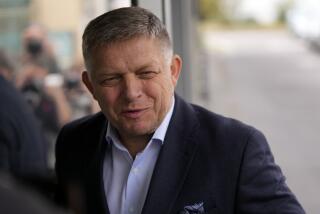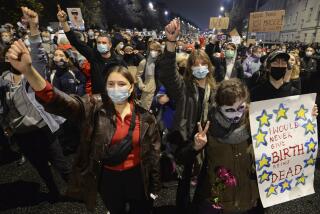Yugoslavia Is Quietly Leading the Reforms in Eastern Europe : Economics: The prime minister’s liberal plans have trimmed hyperinflation and opened the nation’s markets to foreign investors.
BELGRADE, Yugoslavia — While the world was captivated by the breathtaking collapse of communism in Eastern Europe last year, Yugoslavia was carrying out an economic revolution that was almost unnoticed.
Reforms introduced in December by Prime Minister Ante Markovic have tamed four-digit hyperinflation and made the dinar Eastern Europe’s first convertible currency.
Liberal foreign investment laws have given Yugoslavia the most open market in the region, encouraging Western businessmen to put down $1 billion since last year, nearly matching the investment of the previous two decades.
Clever debt-for-equity swaps have chiseled the foreign debt down to $16 billion from $23 billion last year. Stock exchanges have opened in Belgrade, Ljubljana and Zagreb to trade the new shares of private companies.
Despite massive unemployment and some of Europe’s most volatile ethnic flash points, bankers and economists say Yugoslavia may finally be en route to recovery after a decade in crisis.
Prime Minister Markovic is expected to introduce a second phase of belt-tightening measures late this month that will make or break the turnaround, according to Western economic attaches.
The government has played its reform cards close to its vest, but diplomats with good contacts in the fledgling financial community said the next moves are expected to transfer huge segments of state-owned industry to private ownership. Under one scenario, government industries, which account for about 90% of national production, would be shared out to the workers, who could then trade their holdings on the new exchanges.
The successes achieved in less than six months have given Yugoslavia’s 23 million citizens their first cause for hope in years. But some of the most painful steps are still ahead of them.
Many of Yugoslavia’s biggest industries face bankruptcy, according to Desimir Guzina, director of the national Institute for Social Planning. Western diplomats said one-third of the state-owned enterprises are operating in the red.
Unemployment already exceeds 17% nationwide--nearly 40% in the troubled Serbian province of Kosovo, where ethnic Albanians have been agitating for autonomy with strikes, demonstrations and riots.
Economists in Belgrade warn that the employment picture will get much worse before it gets better, as the next wave of reform is expected to loosen or eliminate old socialist restrictions on the firing of workers.
Guzina, whose institute has guided the drafting of economic reforms, said surplus labor is a big problem, and that “we estimate that there are between 1 million and 1.5 million underemployed workers.”
The government hopes to cushion the blow for some of those to be laid off by providing loans equal to up to two years’ salary to get them started in private businesses. This could help fill the gaping hole in consumer services. Guzina said more than 10,000 small-business licenses had been issued since January in a sudden boom for the private sector.
An overhaul of the tax system and development of capital markets remain daunting tasks for the leadership, but foreign experts say Markovic appears to be willing to make those moves.
“I think this place is really poised to take off,” said an American banker who has spent seven years monitoring the Belgrade government’s adherence to debt-rescheduling conditions. “A lot more people are compelled to look at this part of the world now, afraid they’ll miss something.”
Foreign investors may be drawn to the new democracies spawned by last year’s revolutions in Eastern Europe, but analysis of economic conditions in each could attract them to Yugoslavia.
Yugoslavia had a head start in the transition to a free market from a centrally planned socialist economy. Its concept of “self-management” gave state factory managers some autonomy as far back as 1965, and more liberal travel regulations have allowed millions to visit the West and take hard-currency jobs there.
The overnight convertibility of the dinar drew in large sums of foreign money, giving a healthy boost to Yugoslavia’s hard-currency reserves. They have risen from $6 billion to $8 billion since January.
Restoring faith in the currency has been Markovic’s biggest success. A year ago, Yugoslavs protested their economic plight by throwing dinars by the million into fountains and trash cans.
Markovic lopped four zeroes from bills denominated in five- to seven-digit numbers, then pegged the currency to the West German mark at 7 to 1, or about 11.5 dinars to the U.S. dollar.
By executing a radical economic transition, Markovic turned the tables on what has become Eastern Europe’s model for reform. U.S. Ambassador Warren Zimmermann recently noted that while nations like Hungary, East Germany and Czechoslovakia pressed for economic reform with political revolutions, in Yugoslavia “major change in the economy has been driving political reform.”
Yugoslavia’s constant and evolving political drama has been a drag on economic advance. The six republics and two provinces forcibly melded into a nation in 1918 have been developing in markedly different directions.
Slovenia and Croatia, the two most prosperous republics, held free elections this spring that ended 45 years of Communist rule and provided new impetus to their drive for integration with West European markets.
Multiparty elections are scheduled for this fall in all the other republics except Serbia, which has resisted open elections for fear of losing control of rebellious Kosovo province. Of Kosovo’s 2 million people, 90% are Albanians, and they would easily win there. The Albanians of Kosovo have already declared their aim of forming a separate republic.
But Slovenia and Croatia have threatened to secede from the federation unless one-party rule at the federal level is ended and a looser confederation is negotiated among the six republics.
“It’s hard to say what a Yugoslav confederation would mean; there is no agreement on this,” said Srecko Medic, chief political adviser to the collective federal presidency. “We have debts and other obligations to foreign countries. These issues would have to be addressed before we could consider restructuring into independent states within a confederation.”
The prime minister, whose popularity has been rising with his nation’s economic prospects, announced in late May that he would form a new party to challenge the Communists. He said he hoped that multiparty elections could be held before the end of the year.
Nationalist figures in Serbia and Croatia have broad support in Yugoslavia’s two largest republics. But the 65-year-old Markovic has gained in popularity in recent months, emerging as the first nationally accepted political figure since Josip Broz Tito, the postwar leader who died in 1980.
If the prime minister can carry off the tough second phase of the recovery, Yugoslavs could decide to put nationalist considerations aside in favor of a leader committed to keeping the federation together.
More to Read
Sign up for Essential California
The most important California stories and recommendations in your inbox every morning.
You may occasionally receive promotional content from the Los Angeles Times.











